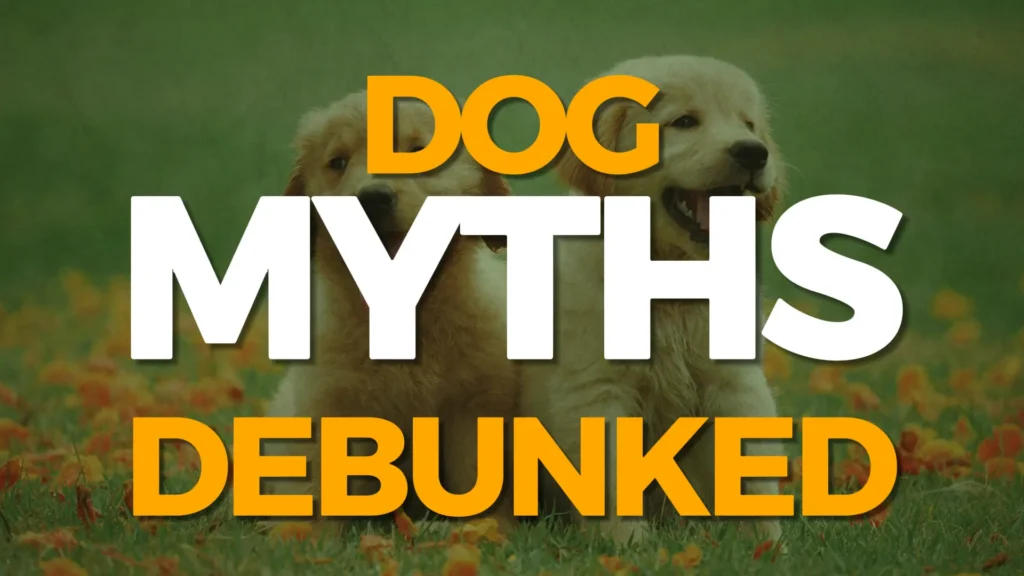Dogs have been humanity’s steadfast companions for over 30,000 years. They’ve earned a special place in our hearts. Yet, despite this enduring bond, myths and misconceptions about dogs abound. These has clouded our understanding of their behavior, biology, and needs.
These tales mislead even the most devoted pet owners. Some misconceptions potentially affect our way of caring. In this article, we’ll tackle ten of the most persistent dog myths to uncover the fascinating truths beneath. Let’s set the record straight and celebrate the real nature of our four-legged pals.
Myth 1: A Wagging Tail Always Means a Happy Dog
Few images are as iconic as a dog wagging its tail. It’s a universal symbol of canine joy so we think.
A wagging tail can indeed signal happiness. But it’s not a foolproof indicator of a dog’s emotional state. Dogs also wag their tails when they’re agitated, and gearing up for a confrontation. The key to decoding this behavior lies in the nuances: speed, direction, and accompanying body language.
A slow, stiff wag paired with raised hackles, pinned-back ears, and a rigid stance might mean a dog is feeling threatened. Conversely, a fast, loose wag—often with a full-body wiggle, relaxed ears, and a soft gaze—typically reflects genuine delight.
Context matters too: a wag at the sight of a treat differs from one during a standoff with another dog. By focusing on the whole picture, you can better understand what dogs are trying to tell.
Myth 2: Dogs Only See in Black and White
The notion that dogs see the world in grayscale has lingered since the early 20th century. Modern research, however, paints a colorful picture.
Dogs have dichromatic vision. They possess two types of color receptors (cones) in their eyes, compared to the three in humans. This limits their spectrum to blues and yellows, while reds, greens, and oranges blur into shades of gray or yellow.
Imagine a sunset for a dog. We see fiery reds; they might perceive a muted yellowish haze. Jay Neitz and colleagues confirmed this by training dogs to distinguish colors in controlled settings.
Beyond color, dogs excel in low-light conditions thanks to more rod cells and a reflective layer called the tapetum lucidum. This enhances night vision and gives their eyes that eerie glow.
So, while they won’t appreciate a rainbow’s full glory, their world is far from monochromatic—and perfectly suited to their needs as crepuscular hunters.
Myth 3: One Dog Year Equals Seven Human Years
The “one dog year equals seven human years” rule is a catchy simplification. It’s a myth that fails to capture the complexity of canine aging. This formula likely emerged as a rough average, based on dogs living 10-12 years and humans reaching 70-80.
Yet, it ignores critical variables: breed, size, and life stage. Small dogs live into their mid-to-late teens, while giant breeds may only reach 7-10 years. A dog’s first year is a whirlwind of growth, roughly equivalent to 15 human years. After that, the aging rate slows, averaging 4-5 human years per dog year. Larger breeds age faster.
For example, a 5-year-old Chihuahua might be in its early 30s in “human years,” while a 5-year-old Mastiff could be closer to its 50s. Veterinarians now use breed-specific aging charts, factoring in genetics and size. They use it to provide a more accurate picture. Ditch the seven-year myth—your dog’s true age deserves a tailored calculation.
Myth 4: Dogs Eat Grass Because They’re Sick
When a dog grazes on the backyard lawn, owners assume it’s self-medicating for a stomachache. This idea has some basis: grass can irritate the stomach lining, prompting a purge. But it’s not the whole story.
Researchers suggest multiple motives: some dogs may enjoy the taste, a trait possibly inherited from wild ancestors who ate plant matter. Others might do it out of boredom, curiosity, and a need for dietary fiber.
Wolves, dog’s ancestor, regularly consume grass without apparent distress. Excessive grass-eating warrants a vet check.
Myth 5: You Can’t Teach an Old Dog New Tricks
This proverb implies that age dims a dog’s ability to learn. Fortunately, it’s a myth with no grounding in canine cognition. Dogs of all ages can learn new skills, from basic commands to complex tricks, as long as training is consistent and positive.
The truth is that senior dogs performed comparably to youngsters on new tasks, though they sometimes needed more repetitions. Age-related hearing loss or arthritis might slow them down, but their brains remain active. They are capable of forming new neural connections.
Training also doubles mental exercise. They are vital for warding off cognitive dysfunction in older dogs. Whether it’s teaching a 10-year-old spaniel to roll over or a 12-year-old mutt to fetch, the limit isn’t their age—it’s our patience and creativity.
Myth 6: Dry Noses Mean a Dog Is Sick
A dry nose often sparks worry. Owners fear fever or dehydration.
This myth likely stems from the association of wet noses with health. Dogs naturally keep their snouts moist through licking and nasal secretions. But moisture levels fluctuate daily. Dryness can result from a nap near a heater, low humidity, and simply not licking for a while.
Actually, there is no correlation between nose temperature and illness. For confirmation, look for other symptoms like persistent lethargy, loss of appetite, vomiting, and unusual nasal discharge. A quick touch-test isn’t enough.
Monitor your dog’s overall behavior and consult a vet if something feels off. The nose alone isn’t a crystal ball.
Myth 7: Dogs Feel Guilt When They Misbehave
You come home to a toppled trash can. Your dog slinks over with droopy ears and a tucked tail. Guilt, right? Not quite. We anthropomorphize those “sorry” looks. But dogs don’t experience guilt as humans do.
A landmark 2009 study by Alexandra Horowitz tested this: dogs displayed “guilty” behaviors when scolded, even if they hadn’t misbehaved. The real trigger? Our cues—angry tones, pointed fingers, furrowed brows.
Dogs are exquisitely attuned to our emotions. They react with submissive gestures to appease us, not because they’re reflecting on their sins. This doesn’t mean they’re emotionless; they feel joy, fear, and affection aplenty.
But complex emotions like guilt or shame require self-awareness dogs likely lack. They’re not confessing—they’re reading the room.
Myth 8: All Dogs Are Natural Swimmers
The term doggy paddle suggests every dog is born with an innate knack for swimming. But reality begs to differ.
Labradors, Golden Retrievers, and Newfoundlands thrive in water, others flail. Brachycephalic breeds (pugs, bulldogs) with short snouts struggle to breathe while paddling. They risk exhaustion and drowning.
Long-bodied, short-legged dogs (dachshunds, bassets) lack the stamina for sustained swimming. Temperament plays a role too. Some dogs dread water due to past trauma. If you’re testing the waters for dogs, start shallow, watch for panic, and consider a life vest. Not every dog is destined for the doggy Olympics.
Myth 9: A Dog’s Mouth Is Cleaner Than a Human’s
This myth likely arose from dogs licking wounds, a behavior tied to saliva’s mild antibacterial enzymes like lysozyme. Historical anecdotes of dogs healing minor cuts fueled the idea further. But cleaner than a human’s? Hardly.
Dogs’ mouths teem with bacteria—Pasteurella, Capnocytophaga, Staphylococcus. They are harmless to them but risky for us. Humans have their own oral flora, shaped by diet and hygiene.
A 2012 study in Archives of Oral Biology compared microbial profiles and found neither species’ mouth is inherently cleaner. They’re just different ecosystems. Dogs explore with their mouths—licking floors, sniffing trash, eating questionable finds. So their kisses aren’t sanitary by default. Brushing their teeth and regular vet checkups keep their mouths healthy.
Myth 10: Dogs Don’t Need Exercise in Winter
As snow falls and temperatures plummet, it’s tempting to skip the walk. This myth overlooks their year-round need for physical and mental stimulation.
Active breeds crave cold-weather romps—snow is their playground. Even less energetic dogs benefit from short outings to burn calories and stave off cabin fever.
Reduced exercise is linked to increased anxiety and destructive behavior in dogs. Adjust for the season: shorter walks, booties for icy paws, and indoor games. A bored dog doesn’t care if it’s April or December. They’ll chew your boots either way.
Some dog myths distort our view of them. By debunking these tales, we peel back the layers of misunderstanding to reveal their true selves. This clarity empowers us to care for them better, tailoring our love to their real biology and behaviors.




